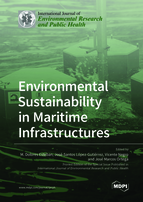Environmental Sustainability in Maritime Infrastructures
A special issue of International Journal of Environmental Research and Public Health (ISSN 1660-4601). This special issue belongs to the section "Environmental Science and Engineering".
Deadline for manuscript submissions: closed (31 May 2021) | Viewed by 42439
Special Issue Editors
2. Department of Civil Engineering, European University of Madrid, 28670 Madrid, Spain
Interests: marine renewable energy; offshore wind; wave energy; maritime engineering; coastal engineering; offshore engineering
Special Issues, Collections and Topics in MDPI journals
Interests: marine renewable energy; offshore wind; wave energy; maritime engineering; coastal engineering; offshore engineering
Special Issues, Collections and Topics in MDPI journals
Interests: marine renewable energy; offshore wind; wave energy; maritime engineering; coastal engineering; offshore engineering
Special Issues, Collections and Topics in MDPI journals
Interests: concrete; durability; sustainability; microstructure; performance in aggressive environments; nondestructive techniques
Special Issues, Collections and Topics in MDPI journals
Special Issue Information
Dear Colleagues,
Oceans and coastal areas are essential in our lifes from different point of view: social, economic and health. Given the importance of these areas for human life, not only for the present but also for the future, it is necessary to plan future infrastructures, and maintain and adapt to the changes the existing ones. All of this taking into account the sustainability of our planet. A very significant percentage of the world's population lives permanently or enjoys their vacation periods in coastal zones, which makes them very sensitive areas, with a very high economic value and as a focus of adverse effects on public health and ecosystems. Therefore, it is considered very relevant and of great interest to launch this Special Issue to cover any aspects related to the vulnerability of coastal systems and their inhabitants (water pollution, coastal flooding, climate change, overpopulation, urban planning, waste water, plastics at sea, effects on ecosystems, etc.), as well as the use of ocean resources (fisheries, energy, tourism areas, etc.). Papers related to these or similar topics are welcome to this Special Issue.
Prof. Dr. M. Dolores Esteban
Prof. Dr. José-Santos López-Gutiérrez
Prof. Dr. Vicente Negro
Prof. Dr. José Marcos Ortega
Guest Editors
Manuscript Submission Information
Manuscripts should be submitted online at www.mdpi.com by registering and logging in to this website. Once you are registered, click here to go to the submission form. Manuscripts can be submitted until the deadline. All submissions that pass pre-check are peer-reviewed. Accepted papers will be published continuously in the journal (as soon as accepted) and will be listed together on the special issue website. Research articles, review articles as well as short communications are invited. For planned papers, a title and short abstract (about 100 words) can be sent to the Editorial Office for announcement on this website.
Submitted manuscripts should not have been published previously, nor be under consideration for publication elsewhere (except conference proceedings papers). All manuscripts are thoroughly refereed through a single-blind peer-review process. A guide for authors and other relevant information for submission of manuscripts is available on the Instructions for Authors page. International Journal of Environmental Research and Public Health is an international peer-reviewed open access monthly journal published by MDPI.
Please visit the Instructions for Authors page before submitting a manuscript. The Article Processing Charge (APC) for publication in this open access journal is 2500 CHF (Swiss Francs). Submitted papers should be well formatted and use good English. Authors may use MDPI's English editing service prior to publication or during author revisions.
Keywords
- Coastal areas
- public health
- ecosistems vulnerability
- climate change
- fisheries
- energy
- tourism
- water pollution
- coastal floodind
- waste water management









